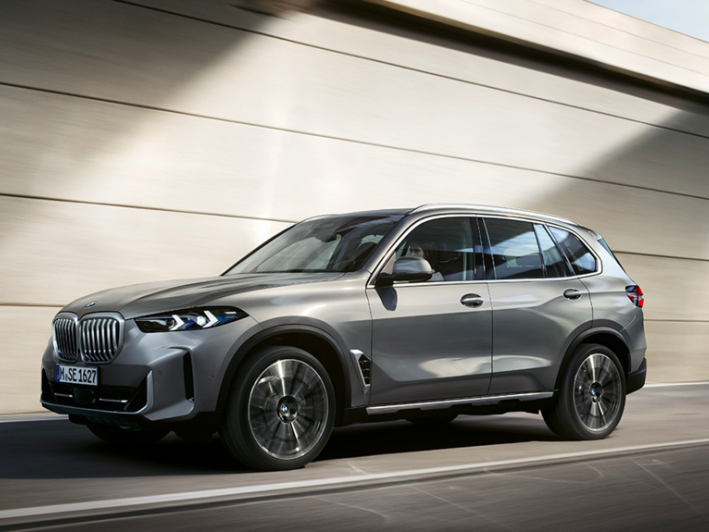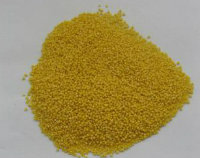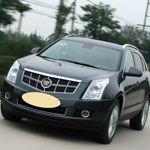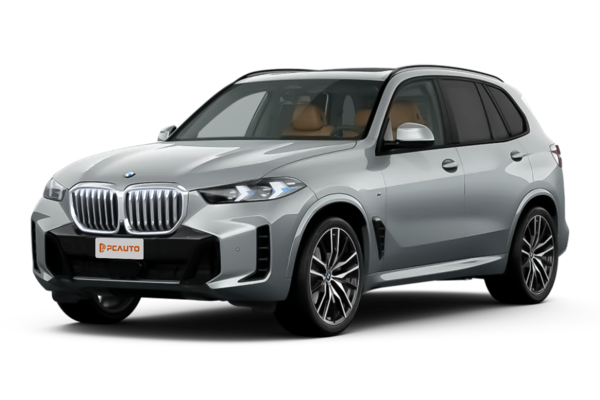Q
How much is the BMW X5 in 2024?
Pricing for the 2024 BMW X5 in Malaysia varies depending on the trim and specs you go for. The entry-level X5 sDrive40i starts at around RM 500,000, while the high-performance X5 M60i xDrive can push past RM 800,000. For the most accurate figures, you'll want to check with local dealerships for their latest quotes and any ongoing promotions.
The BMW X5 has long stood out in the luxury SUV segment, and it's easy to see why—think sharp driving dynamics, a seriously premium interior, and all the latest tech. Highlights include the new iDrive 8.0 infotainment system and a solid suite of driver assistance features that make every drive smoother.
Over in Malaysia, the X5 faces stiff competition from heavyweights like the Mercedes-Benz GLE and Audi Q7, both of which bring their own takes on luxury and cutting-edge tech to the table. If you're in the market, price is just one piece of the puzzle. It's smart to factor in after-sales service, warranty coverage, and fuel efficiency too, to make sure you land on the SUV that best fits your lifestyle.
One thing working in BMW's favor is their widespread dealer network across Malaysia, which means owners can count on reliable after-sales support and maintenance. Let's be real, that peace of mind is a big deal when you're investing in a luxury ride.
Special Disclaimer: This content is published by users and does not represent the views or position of PCauto.
Related Q&A
Q
Does the 2024 BMW X5 qualify for tax credits?
The 2024 BMW X5 doesn't currently qualify for tax incentives in Malaysia. Here's the deal: Malaysia's tax breaks are mainly aimed at locally-assembled (CKD) Energy Efficient Vehicles (EEVs) or electric vehicles. Since the X5 is a fully imported (CBU) model and runs on good old-fashioned petrol, it's generally left out of those schemes.
To encourage greener choices, the Malaysian government offers reductions on import duties and sales tax for cars with EEV certification or fully electric vehicles. You'll see some hybrids or EVs getting those tax perks, for example. If you're into more efficient options, BMW's plug-in hybrids like the X5 xDrive45e might be worth a look – they could score some tax relief under certain conditions.
Before you take the plunge, though, it's smart to check in with the Royal Malaysian Customs Department or your nearest BMW dealership for the latest info. Tax incentives can shift with the annual budget announcements, so you don't want to miss any updates. On top of that, Malaysia slaps pretty hefty tariffs on imported luxury cars, and that's another reason the X5 comes with a higher price tag here.
Q
How much does it cost to maintain a BMW in 2024?
The cost of maintaining a BMW in Malaysia for 2024 varies depending on the model, age of the car, and the specific services needed. Generally speaking, a routine service – which covers an oil change, oil filter replacement, and basic inspections – will set you back around 800 to 1,500 Malaysian Ringgit. For more extensive services, like changing brake pads or transmission fluid, you're looking at 2,000 to 4,000 Ringgit or even more, depending on the BMW model and the pricing at the authorized service center.
As a luxury brand, BMWs do come with relatively higher maintenance costs. Part of that is down to the use of high-performance components and precision engineering, but these also help ensure your car stays in top shape for the long haul. Another option for owners is BMW's official service packages. These usually let you save some money and make budgeting more straightforward.
It's worth remembering that regular maintenance isn't just about keeping your car running smoothly – it also helps preserve its resale value when the time comes to sell. So, it's a good idea to stick strictly to BMW's recommended service intervals and choose official or certified service centers to guarantee quality work. If you're watching your budget, certified third-party BMW workshops can be an alternative, but make sure they meet the required technical standards and have access to genuine parts.
Q
How much is insurance on a 2024 BMW X5?
In Malaysia, insurance costs for the 2024 BMW X5 can vary quite a bit, typically ranging from around RM8,000 to RM15,000 annually. The exact figure hinges on several factors: the specific model (like the xDrive40i or M50i), engine displacement, the owner's age and driving history, the type of coverage (comprehensive vs. third-party only), and the insurance company's discount structure – with No Claim Discounts (NCD) potentially slashing premiums by up to 55%.
Then there's the reality of insuring a luxury vehicle: repair costs and import duties on parts play a big role here. As a premium SUV, the X5's genuine parts and servicing tend to be pricier than your average car, which naturally bumps up the insurance tab.
My advice? Head to insurance company websites or chat with agents to get accurate quotes. It’s also smart to compare the extra perks different providers offer, like roadside assistance or specific policy clauses. Malaysia’s insurance market also throws in add-ons such as natural disaster coverage – definitely worth considering if you’re in an area prone to heavy monsoons.
Understanding all these variables will help you budget smarter for your X5 and make sure you’re getting the right level of protection.
Q
How much does it cost to own a 2024 BMW X5?
The cost of owning a 2024 BMW X5 in Malaysia really depends on the specific trim and how you spec it out. Brand-new, you're looking at starting prices around RM500,000, and if you go all-in on the top-of-the-line model, it can easily push past RM700,000. That bottom line includes the purchase price, insurance, road tax, registration fees, and then there's the day-to-day running costs to factor in too.
Insurance is one of those variables – it'll swing based on your age and driving history, but you're generally looking at somewhere between RM8,000 to RM15,000 annually. Road tax, on the other hand, is calculated by engine displacement; for the 3.0-liter models, that's roughly RM2,500 a year.
Now, when it comes to maintenance, BMWs aren't the cheapest to upkeep. Regular servicing every 10,000 km or 12 months (whichever comes first) will set you back around RM2,000 to RM4,000. And let's not forget fuel – the 3.0L variants return a combined fuel economy of about 10 to 12 liters per 100 km, though that'll vary depending on how heavy your right foot is.
For prospective buyers, beyond just the upfront budget, it's smart to look into BMW's warranty and after-sales package. Typically, they offer a 5-year, unlimited-mileage warranty as standard, which does help ease some long-term ownership worries. If you're financing, you'll need to tack on interest costs too. Car loan interest rates in Malaysia usually hover between 2.5% to 3.5%, so it's definitely worth shopping around and comparing deals from different banks before signing on the dotted line.
Q
Is the BMW X5 made in China?
The BMW X5 Long Wheelbase version (G18) currently on sale in the Chinese market is produced at the BMW Brilliance Shenyang plant. This is a localized model launched by BMW to cater to Chinese consumers' demand for luxury SUVs. The standard wheelbase X5 (G05), on the other hand, is mainly imported into China from BMW's Spartanburg plant in the United States or its Rayong plant in Thailand.
As for the Malaysian market, the BMW X5s currently available are primarily imported from the Rayong plant in Thailand. Thanks to the tariff preferential agreements among ASEAN countries, BMW X5s imported from Thailand are more price-competitive. Malaysian consumers can enjoy BMW X5 quality that's on par with global standards, and at the same time, the models produced at the Thai plant have undergone adaptive adjustments for the tropical climate in Southeast Asia, such as enhanced air conditioning systems and improved heat dissipation performance.
It's worth mentioning that BMW has factories in multiple regions worldwide. This global production layout allows it to better meet the needs of different markets while ensuring consistent product quality. For Malaysian consumers, no matter which factory the BMW X5 is produced in, it has passed BMW's strict global unified quality standards inspection and can be purchased with confidence.
Q
Where is the 2024 BMW X5 built?
The 2024 BMW X5 is primarily built at the Spartanburg plant in Germany, one of BMW Group's largest production facilities worldwide. This factory specializes in crafting the brand's X-series SUVs, churning out models like the X3, X4, X5, X6, and X7. It's renowned for its high level of automation and strict quality control measures, ensuring every vehicle rolling off the line meets global standards. For the Malaysian market, some X5 units might also be brought in via import, and local customers can check with authorized dealers to confirm the specific origin of their desired vehicle.
As a luxury midsize to large SUV, the BMW X5 has always been a hit, thanks to its impressive driving dynamics, plush interiors, and cutting-edge tech features. The 2024 iteration takes things up a notch, particularly with upgrades to its intelligent driver assistance systems and plug-in hybrid variant, making it a strong fit for Malaysian buyers seeking a premium SUV experience. Here in Malaysia, BMW backs its vehicles with a comprehensive dealer network that provides after-sales service and genuine factory warranties, ensuring owners enjoy a top-notch ownership journey.
Q
How comfortable are the 2024 X5 seats?
The seats in the 2024 BMW X5 are absolute standouts when it comes to comfort. They’re wrapped in high - quality leather and feature an ergonomic design that delivers exceptional support and a snug, reassuring feel—perfect for those long drives where you don’t want to feel exhausted by the end. The adjustability is top - notch too: multiple power - adjustable settings allow you to find your ideal position, and then there’s the heating, cooling, and even massage functions. Trust me, in Malaysia’s sweltering heat, that cooling feature isn’t just a luxury—it’s a game - changer for keeping you comfortable in the passenger seat. BMW hasn’t forgotten about rear passengers either. The back seats get some love with extra legroom and adjustable backrest angles, making those longer journeys much more comfortable for everyone on board. What I really appreciate about BMW’s approach to seats is its commitment to balancing comfort with safety and durability. They don’t simply use soft padding and consider it sufficient—these seats are built to last and keep you secure. For the Malaysian market, they’ve clearly paid attention to local preferences. The seat padding feels a bit plusher, and the materials seem chosen to handle our tropical climate better, which is a nice touch. If you’re someone who prioritizes seat comfort—whether you’re chauffeuring clients or just treating yourself— the 2024 X5’s seats are definitely worth experiencing firsthand. This one’s a strong contender if comfort is high on your checklist.
Q
What BMW to buy in 2024?
If you're looking to buy a BMW in Malaysia in 2024, the 3 Series and X3 are solid picks—both have strong local market performance and cater to different needs. The 3 Series is all about that sweet handling and premium cabin feel, perfect if you actually enjoy driving. The X3, on the other hand, nails it as a family hauler with its roomy interior and efficient powertrains. Got a bigger budget? Keep an eye on the all-new 5 Series or the iX electric SUV. The 5 Series steps up the comfort and tech game, while the iX showcases BMW's latest in electrification—seriously impressive range and performance there. Malaysia's hot weather and road conditions can be tough on cars, but BMW's cooling systems and adaptive suspensions handle it like a pro. Oh, and don't sleep on the tax incentives for hybrids and EVs here—snagging a plug-in hybrid like the 330e or X5 xDrive45e could save you some cash on taxes. No matter which BMW you lean towards, hit up an authorized dealer for a test drive, check out the latest promotions, and factor in long-term maintenance costs and warranty coverage to make sure you're getting the best ownership experience possible.
Q
What are the pros and cons of the 2024 X5?
The 2024 BMW X5 is making waves in the Malaysian market, and it's easy to see why. Under the hood, you've got some serious muscle to choose from – the smooth 3.0L inline-six and the beastly 4.4L V8, both paired with that handy 48V mild-hybrid setup. That means you don't have to choose between performance and fuel efficiency; you get a bit of both. Step inside, and it's all premium materials, plus the latest iDrive 8.5 system that keeps things feeling super tech-forward. Space-wise, it's got plenty, making it a solid pick for families too. And let's not forget the upgraded driving assistance systems – they're smarter than ever, which definitely adds to that peace of mind behind the wheel.
Of course, it's not all sunshine and rainbows. The X5 does come with a pretty steep price tag, and let's be real, maintenance and repairs won't be cheap either. Another thing to consider is its size; those bigger dimensions can feel a bit cumbersome when navigating Malaysia's tighter city streets.
So, for Malaysian buyers, the X5 is a really compelling blend of luxury and practicality in an SUV package. But you've gotta be honest with yourself about your budget and how you'll actually use it day-to-day. If you're shopping around, the Mercedes-Benz GLE and Audi Q7 are obvious rivals, each with their own strengths. The GLE leans hard into comfort, while the Q7 tends to shine a bit more when it comes to tech gadgets. At the end of the day, it all boils down to personal taste and what matters most to you.
Q
What is the difference between the BMW 2024 and 2025?
The main differences between the 2024 and 2025 BMW models will likely boil down to tech upgrades and spec tweaks. The 2025MY is expected to get minor refinements in the infotainment system, driver assistance features, and powertrains – think maybe an updated iDrive version or more advanced sensors. You might also spot subtle exterior tweaks, like revised grille designs or new wheel options, while the interior could offer fresh material choices or color schemes to keep things feeling current.
For Malaysian buyers, a key thing to watch is whether these updates make it to locally-introduced models. Market-specific strategies can lead to spec variations, such as cooling systems optimized for tropical climates or right-hand-drive-specific adjustments. It’s worth remembering BMW typically follows a "minor updates yearly, full redesign every 7 years" cycle. If 2024-2025 isn’t a full redesign year, changes might be pretty subtle. Your best bet is to check the official BMW Malaysia website or authorized dealers for detailed spec sheets on specific models. Also, keep an eye on ASEAN NCAP safety ratings – if new features are added, ratings might adjust, which is helpful for evaluating a car’s suitability in Malaysia’s tropical, rain-heavy conditions.
Latest Q&A
Q
What is the CC of Honda City 2020?
The 2020 Honda City hits the Malaysian market with two engine choices: a 1.5-liter SOHC i-VTEC naturally aspirated petrol engine and a 1.5-liter DOHC i-VTEC hybrid system. Let's break down the specs. The petrol unit displaces 1497cc, cranking out 121 horsepower and 145 Nm of torque. On the hybrid side, it pairs that same 1.5-liter engine with an electric motor, resulting in a combined 109 horsepower – this one's all about fuel sipping efficiency.
Now, CC (cubic centimeters) is the measure of engine displacement, and it directly impacts how a car performs and drinks fuel. Typically, a bigger displacement means more power, but it can also mean higher fuel bills. The City's 1.5-liter sweet spot is a big reason it's so popular in Malaysia – it strikes that perfect balance between pep and fuel economy, handling both city commutes and longer drives like a champ.
But the 2020 City isn't just about the engine bay. It also comes loaded with Honda Sensing safety tech and a modern, fresh interior design, which really ups its game in the market. For Malaysian buyers, this car ticks all the boxes: practical, easy on the wallet at the pump, and packed with the latest tech. It's a solid all-rounder.
Q
How much does a Honda 2020 cost?
Prices for the 2020 Honda models in Malaysia vary quite a bit depending on the specific model and how it's kitted out. Take the Honda City, for example – you're looking at roughly RM70,000 to RM90,000. The Civic sits a bit higher, usually ranging from around RM110,000 up to RM140,000, while the CR-V typically falls between RM140,000 and RM170,000. exact figures hinge on the trim level, engine specs, and any extra add-ons you might go for.
When buying a new car in Malaysia, it's not just the sticker price you need to factor in. There's registration fees, insurance, road tax – all that extra stuff adds up and affects the final on-the-road cost.
Over in the used car market, 2020 Honda models will fluctuate in price too, based on mileage, condition, and remaining warranty. You can generally pick one up for 20% to 40% less than a brand-new equivalent.
If you're in the market, I'd definitely recommend shopping around different dealers to compare quotes. It's also worth checking out any ongoing Honda promotions or financing deals – those can really help you save some cash.
Hondas have a solid rep in Malaysia for being reliable and fuel-efficient, especially popular models like the City and Civic. They're pretty affordable to own long-term, and getting them serviced or repaired is relatively straightforward.
Q
What is the top speed of Honda City 2020?
The 2020 Honda City maxes out at around 190 km/h, which is the top speed you can squeeze out of its 1.5-liter i-VTEC naturally aspirated engine under ideal conditions. Of course, in the real world, you might see a slight difference depending on road conditions, how much you're carrying, or the weather. This car is pretty popular in the Malaysian market, and it's not just because of its solid performance—it's also about that fuel efficiency and nimble handling that makes city driving a breeze. The CVT gearbox in the City does a good job smoothing out power delivery, so acceleration feels seamless and efficient, whether you're commuting daily or hitting the highway for a longer drive. For Malaysian buyers, beyond just top speed, overall performance and maintenance costs matter a lot, and the City delivers here too. Its low trouble rate and wide service network make life easier for owners. If you're craving a bit more zip, there's always the Honda City RS variant. It gets some tweaks to the engine tuning and sportier bits, but don't expect a huge jump in top speed—these cars are all about balancing practicality with a bit of driving fun, after all.
Q
How safe is the Honda City 2020?
The 2020 Honda City holds its own when it comes to safety, packing in 6 airbags, Vehicle Stability Assist (VSA), Anti-lock Braking System (ABS), and Electronic Brake-force Distribution (EBD). That's a pretty solid setup for the class, and it should do a good job of keeping you protected during those daily drives around Malaysia. Honda's ACE Body Structure is also on board here, which is designed to effectively disperse crash energy and boost occupant safety in the event of a collision. It's worth highlighting that the 2020 City scored a 5-star rating in ASEAN NCAP crash tests, which is a solid stamp of approval for its safety credentials. For Malaysian buyers, picking this car means you're not just getting Honda's usual reputation for reliability, but also a decent level of safety kit. If safety is a top priority for you, it's definitely worth checking out the specific safety features when you're looking to buy – things like whether it comes with Honda Sensing. That suite includes handy advanced features like Adaptive Cruise Control and Lane Keeping Assist, which can go a long way in making your drives even safer.
Q
What is the fuel economy of the Honda City 2020?
The 2020 Honda City demonstrates excellent fuel efficiency in the Malaysian market. The variant equipped with the 1.5L i-VTEC petrol engine and CVT transmission has an official combined fuel consumption of 5.4 L/100km (approximately 18.5 km/L). The hybrid e:HEV variant is designed for even higher efficiency, though its specific fuel consumption figure should be verified with official sources or latest reviews, as the widely cited 3.4 L/100km (approximately 29.4 km/L) lacks direct support in the provided search results and may not reflect real-world conditions in Malaysia. Both powertrains closely align with the demands of Malaysian consumers who prioritize fuel economy. Actual fuel consumption may vary depending on factors such as driving habits, road conditions, and vehicle load. Therefore, adhering to a regular maintenance schedule is crucial for maintaining optimal fuel efficiency.
Given Malaysia's hot and humid climate, judicious use of the air conditioning system and maintaining the recommended tire pressure can contribute significantly to improving fuel economy. As a top-selling model in the B-segment sedan market in Malaysia, the Honda City's fuel efficiency remains competitive against its peers, making it a practical choice for daily commuting and family use. The e:HEV hybrid version, in particular, presents a compelling option for environmentally conscious drivers seeking to minimize long-term running costs, pending verification of its specific fuel economy claims.
View MoreRelated News

BMW X5 will become BMW's first model equipped with a hydrogen fuel cell, with a range of 504 kilometers
JamesSep 8, 2025

How strong is the overall strength of the BMW X5 that it even makes the wealthy give up the Benz GLE and Audi Q7?
RobertSep 25, 2024

The 2024 BMW X5 xDrive50e is priced at RM 528,100, with 0-100km/h just taking 4.8 seconds
LienJun 26, 2024

Neue Klasse platform's first mass-produced vehicle, the all-new BMW iX3 makes its debut, looks just like a concept car
LienSep 8, 2025

BMW's all-new iX3 to be unveiled on September 5, built on the Neue Klasse platform
Kevin WongSep 1, 2025
View More


















Pros
Cons